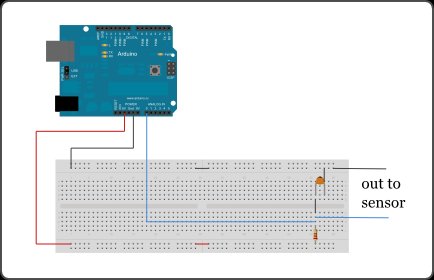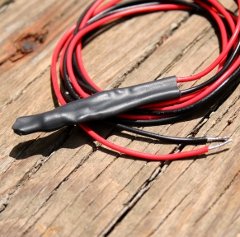You are building a soil temperature sensor. We need a waterproof thermometer that we can burry in the soil. The sensor is made up of a small circuit enclosed in a piece of heat shrink (to waterproof it).
(see the parts page)
- an LM335 temperature sensor
- a 33K and a 56K resistor
- a short piece of glue-lined heat-shrink tubing
- soldering iron and solder
- lead wires
The circuit for the actual sensor
This is the circuit for our waterproof sensor (not to be confused with the local circuit below).
The resistor in this circuit is optional. You can just get the value of the LM335 raw and use it in calculations (see below). But if we want to know the actual temperature we will need to use a resistor to calibrate the sensor.
If you do want to use a resistor, you can make things simpler to wire up in the garden by soldering the resistor(s) inline with this sensor. See more detailed info below to see why this is technically not correct. This resistor is to calibrate the LM335 temperature sensor. The actual value of the resistor will vary from unit to unit. You will need to calibrate it by trying different resistors.
 The ground leg will be tied to the common ground connection with your other sensors. The output leg will need a signal wire to get back to the brain where it will be connected to the local circuit for this module.
The ground leg will be tied to the common ground connection with your other sensors. The output leg will need a signal wire to get back to the brain where it will be connected to the local circuit for this module.
Step-By-Step
Attach the two resistors to the ADJ leg of the LM335. Attach a piece of lead wire to the positive leg that will reach to the end of the ADJ leg.
For more detail: The Soil Temperature Sensor

